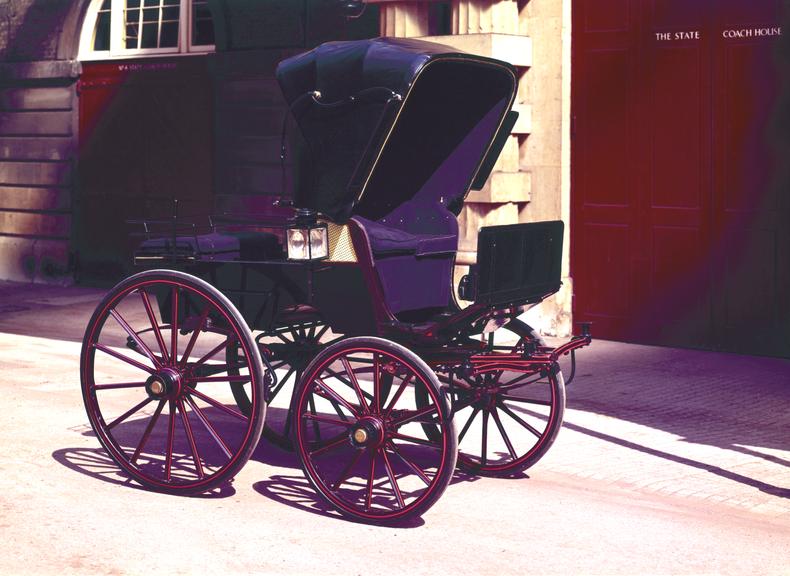
Phaeton Carriage built by Barker and co
A phaeton carriage with a hood, built by Barker and Co in London. A phaeton is a type of owner-driven, four wheeled carriage designed to be pulled by one or two horses. This carriage has four seats, two are located at the back behind the hood and are uncovered (often called rumble seats), and two at the front which includes the driver's seat.
This phaeton has a foldable black leather hood, and black and red royal livery, a color-scheme which the royal family kept for most of the 20th century. On the back of the carriage, behind the rumble seats, is a crest belonging to the Order of the Garter. The front and back seats are covered by dark blue velvet cushions with a gold/yellow trim. A more lavish detail of this carriage is its wicker detailing around the base of the foldable hood.
Like the other Phaetons in this collection, the carriage has a spoon braking system controlled by a pedal below the driver’s seat. The undercarriage and main carriage body are separated by elliptical springs, intended for slow and luxurious drives. The wheels have brass hub caps which have the engraving “Barker and Co, Chandos S.”.
More
Phaetons were one of the most popular and common types of carriages seen in Victorian society and were one of the first carriages designed explicitly to be owner-driven. Owner-driven carriages became increasingly popular among the upper class during the early 19th century, in particular for racing and leisurely carriage driving.
Phaetons were very stylish and early motor cars adopted their likeness in their own designs. Phaeton style cars carried over common features of phaeton carriages, such as foldable hoods and only having two seats. Famous examples of ‘Phaeton body’ style automobiles are the 1930 Studebaker and the Cadillac v-16. Phaeton-style cars were also called spider/spyder (after a variation of phaeton carriage) which evolved into the contemporary term ‘roadster’ which are typically two-seater convertibles.
This phaeton was built by Barker and Co, a coachbuilding company founded in 1710 in Chandos Street, London. They specialised in the production of luxury coaches and carriages for the upper class and the British Royal family. With the rise of the automobile in the early twentieth century, Barker and Co started building car bodies for luxury motor manufacturers and were the recommended supplier of bodywork for early Rolls-Royce cars.
This carriage was one of several donated by King Edward VIII in 1936. Phaetons were popular with Queen Victoria especially, who personally owned several. This popularity continued throughout the Royal family, with King Edward VIII, King George VI, and Queen Elizabeth II who used an 1842 phaeton designed for her great-great-grandmother Queen Victoria every year between 1978-2011 as part of the Trooping the Color parade at Horse Guards.
- Measurements:
-
overall: 3560 mm x 1680 mm x 2420 mm,
- Materials:
- wood (unidentified) , mild steel , textile , brass (copper, zinc alloy) , paint , rubber (unidentified) , natural fibre (unspecified) and leather
- Object Number:
- 1936-601/1
- type:
- carriage
- Image ©
- The Board of Trustees of the Science Museum







